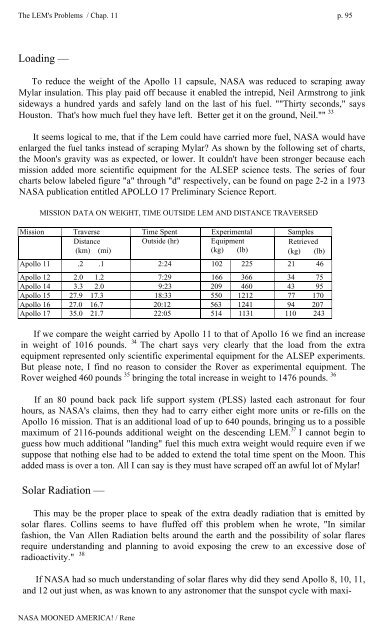Rene-NASA-Mooned-America
Rene-NASA-Mooned-America
Rene-NASA-Mooned-America
You also want an ePaper? Increase the reach of your titles
YUMPU automatically turns print PDFs into web optimized ePapers that Google loves.
The LEM's Problems / Chap. 11 p. 95<br />
Loading —<br />
To reduce the weight of the Apollo 11 capsule, <strong>NASA</strong> was reduced to scraping away<br />
Mylar insulation. This play paid off because it enabled the intrepid, Neil Armstrong to jink<br />
sideways a hundred yards and safely land on the last of his fuel. ""Thirty seconds," says<br />
Houston. That's how much fuel they have left. Better get it on the ground, Neil."" 33<br />
It seems logical to me, that if the Lem could have carried more fuel, <strong>NASA</strong> would have<br />
enlarged the fuel tanks instead of scraping Mylar As shown by the following set of charts,<br />
the Moon's gravity was as expected, or lower. It couldn't have been stronger because each<br />
mission added more scientific equipment for the ALSEP science tests. The series of four<br />
charts below labeled figure "a" through "d" respectively, can be found on page 2-2 in a 1973<br />
<strong>NASA</strong> publication entitled APOLLO 17 Preliminary Science Report.<br />
MISSION DATA ON WEIGHT, TIME OUTSIDE LEM AND DISTANCE TRAVERSED<br />
Mission Traverse Time Spent Experimental Samples<br />
Distance<br />
Outside (hr) Equipment<br />
Retrieved<br />
(km) (mi)<br />
(kg) (lb)<br />
(kg) (lb)<br />
Apollo 11 .2 .1 2:24 102 225 21 46<br />
Apollo 12 2.0 1.2 7:29 166 366 34 75<br />
Apollo 14 3.3 2.0 9:23 209 460 43 95<br />
Apollo 15 27.9 17.3 18:33 550 1212 77 170<br />
Apollo 16 27.0 16.7 20:12 563 1241 94 207<br />
Apollo 17 35.0 21.7 22:05 514 1131 110 243<br />
If we compare the weight carried by Apollo 11 to that of Apollo 16 we find an increase<br />
in weight of 1016 pounds. 34 The chart says very clearly that the load from the extra<br />
equipment represented only scientific experimental equipment for the ALSEP experiments.<br />
But please note, I find no reason to consider the Rover as experimental equipment. The<br />
Rover weighed 460 pounds 35 bringing the total increase in weight to 1476 pounds. 36<br />
If an 80 pound back pack life support system (PLSS) lasted each astronaut for four<br />
hours, as <strong>NASA</strong>'s claims, then they had to carry either eight more units or re-fills on the<br />
Apollo 16 mission. That is an additional load of up to 640 pounds, bringing us to a possible<br />
maximum of 2116-pounds additional weight on the descending LEM. 37 I cannot begin to<br />
guess how much additional "landing" fuel this much extra weight would require even if we<br />
suppose that nothing else had to be added to extend the total time spent on the Moon. This<br />
added mass is over a ton. All I can say is they must have scraped off an awful lot of Mylar!<br />
Solar Radiation —<br />
This may be the proper place to speak of the extra deadly radiation that is emitted by<br />
solar flares. Collins seems to have fluffed off this problem when he wrote, "In similar<br />
fashion, the Van Allen Radiation belts around the earth and the possibility of solar flares<br />
require understanding and planning to avoid exposing the crew to an excessive dose of<br />
radioactivity." 38<br />
If <strong>NASA</strong> had so much understanding of solar flares why did they send Apollo 8, 10, 11,<br />
and 12 out just when, as was known to any astronomer that the sunspot cycle with maxi-<br />
<strong>NASA</strong> MOONED AMERICA! / <strong>Rene</strong>


